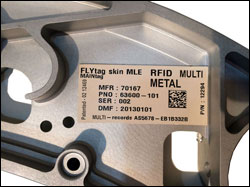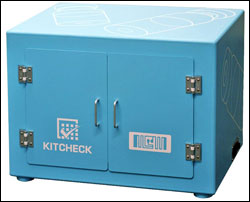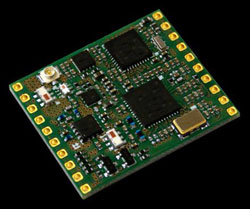The following are news announcements made during the past week by the following organizations:
MAINtag;
Kit Check; the
U.S. Department of Defense;
Lab ID;
iDTronic;
NXP Semiconductors; Smartrac, Confidex;
Tecsys and Logi-D.
MAINtag Announces Deployment of Over 1 Million Flyable Tags, New Deliveries of FLYtag Skin
MAINtag has announced that it delivered more than over 1 million flyable tags to more than 60 tier-one suppliers in the aerospace industry to date, with new deliveries of its FLYtag skin RFID labels to aerospace tier-one original equipment manufacturers (OEMs) planned for this month. “The FLYtag skin family will support RFID expansion in the aerospace industry by substantially simplifying and improving the tracking of chip-equipped parts at an affordable cost,” said Dominique Garreau, MAINtag’s managing director, in a prepared statement. “Since 2010, the cooperation between Airbus and MAINtag has facilitated value creation for both parties. Within terms of an existing multi-year contract, Airbus and MAINtag continue fruitful collaboration.” MAINtag unveiled its first FLYtag skin RFID labels in 2012 (see MAINtag Beefs Up Its RFID Offerings, to Meet Demands in Aerospace). The FLYtag skin integrated RFID label—which is only 1 millimeter in thickness and is available in three sizes—is designed for use on parts (metal or non-metal) installed in an aircraft’s non-pressurized areas, as well as in cabin interiors. The label is made with the company’s FLYchip, a silicon chip available with either 2 kilobits or 64 kilobits of memory. The FLYchip complies not only with the EPC Gen 2 and ISO 18000-6C passive ultrahigh-frequency (UHF) RFID standards, but also with the SAE AS5678, ATA Spec 2000 Chap. 9 and TDS 1.7 specifications. An aircraft company can print part information directly onto the label by means of Zebra Technologies‘ R110Xi4 RFID printer. “Ten years ago, MAINtag was founded and named for ‘MAINtenance tagging’ based on the invention of RFID hybrid label technology to be used for aircraft,” said Bruno Lo-Re, MAINtag Group’s president and CEO, in a prepared statement. “Our patented RFID aircraft maintenance solutions remain at the core of our R&D.”
Kit Check Releases New RFID Scanning Station
Kit Check has released a new RFID scanning station that is used to verify hospital pharmacy kits in five seconds and reduce total restocking time from 30 minutes to just 3 minutes. The new scanning station, known as the Little Blue Box, is a smaller version of the company’s enclosed RFID reader designed to identify medications in pharmacy kits, which are used throughout hospitals for critical care procedures, including operating room anesthesia, crash carts, pediatric emergency, labor and delivery, and many others. The kits typically contain up to 200 medications each. Kit Check’s solution is designed to eliminate the manual processes associated with hospital pharmacy kit replenishments and expiration verifications. Kits are placed on trays tagged with EPC Gen 2 passive ultrahigh-frequency (UHF) RFID tags, and are put into the Kit Check enclosed reader. Every item is also tagged with a similar tag. Kit Check installs Zebra Technologies printers at each hospital. To date, Zebra printers have been used to add RFID tags on more than a million medication vials. Each tray’s tag ID number is married to the tag IDs of all items loaded onto it. A user presses the Scan button, thereby triggering the device to interrogate any tags within. The reader is wired to a PC that transmits read data to a cloud-based server, hosted by Kit Check. Software on the server displays the results on the PC’s monitor. Once a read is accomplished, Kit Check’s software displays which items are missing, which are present in extra quantities and which are soon due to expire. Workers can then use that information to restock the tray. Several hospitals, including the University of Maryland Medical Center (UMMC) in Baltimore (see Hospital Pharmacy Keeps Emergency Medication Kits in Check) and CaroMont Regional Medical Center in Gastonia, N.C., (see North Carolina Hospital Identifies Recalled Drugs Via RFID), are utilizing Kit Check’s solution. The new Little Blue Box weighs about 100 pounds less than the company’s initial solution, and measures 23 3/8 inches deep by 34 ¼ inches wide by 25 inches high (also available is a larger version, measuring 25 inches by 39 inches by 30 inches). “We chose lightweight materials to make the new scanning station easier to move, shrunk the dimensions and even tested a variety of different magnets to ensure the doors make a satisfying ‘thunk’ when closed,” said Nick Petersen, Kit Check’s director of product management, in a prepared statement. “Although we are officially announcing two new scanning station sizes, the new materials also allow us to build custom sizes that are smaller or larger based on need.” The new Little Blue Box will be provided free of charge to all new and existing Kit Check users. Kit Check also supports using Zebra’s new Zatar solution for remotely managing and supporting printers through a cloud-based infrastructure (see Zebra Launches Zatar ‘Internet Of Things’ Service for RFID Readers, Networked Devices).
New DOD Rules for Electronics Parts Contractors Could Spur RFID Use
The U.S. Department of Defense (DOD) has amended the rules for its suppliers, as part of its Defense Federal Acquisition Regulation Supplement: Detection and Avoidance of Counterfeit Electronic Parts (DFARS Case 2012-D055). That regulation is designed to combat the counterfeiting of electronic parts, by requiring that contractors verify the authenticity of the products they supply to the federal government. According to a blog post from Xerafy, the amended rules are tougher and require DOD suppliers to put processes in place to detect potentially counterfeit electronic parts. According to Xerafy, the new rules do not require any specific technology for verifying product authenticity (just like all other U.S. government identification and traceability program policies), but they do create “a new opportunity to apply RFID part identification and traceability solutions, similar to those that are required and being put in place in the commercial aviation industry” (see New DOD Rules a Reminder of RFID Opportunity). The new rules took effect early last month.
Lab ID Introduces Two New RFID Inlays
Italian RFID firm Lab ID has introduced two new ultrahigh-frequency (UHF) EPC Class1 Gen 2 RFID inlays, known as the INSKYL7 and UH4411_7. Both inlays are available with either NXP Semiconductors‘ Ucode 7 chip, or EM Microelectronic-Marin‘s EM4124 or EM4126 chip. The INSKYL7 is designed for apparel applications, logistics and item-level tagging, and can operate at a range of -40 degrees to +85 degrees Celsius (-40 degrees to +185 degrees Fahrenheit). According to Lab ID, the INSKYL7 is designed to work in environments containing a high density of tags, is suitable for item-level logistics and apparel applications, and can also operate at a range of -40 degrees to +85 degrees Celsius.
IDTronic Unveils New UHF RFID Reader Module
iDTronic has unveiled a new ultrahigh-frequency (UHF) embeddable RFID reader module. Designed for logistics, industrial and automation applications, and integration into mobile handheld devices, the Embedded UHF Module Multi ISO TTL/USB supports the ISO 18000-6C and EPC Gen 2 standards. Measuring 25 millimeters by 30 millimeters by 3 millimeters (1 inch by 1.2 inches by 0.1 inch), the module operates at frequencies of 865 to 928 MHz (ETSI and FCC standard) and is powered by a 5Vdc battery. Its power consumption is less than 650 mA, with a maximum power of +27 dBm /500 mW. The read range is 20 millimeters to 40 millimeters (0.8 inch to 1.6 inches), depending on the type and size of the tag and/or antenna. The module comes with a full software developer’s kit (SDK) and Microsoft Window-based application software.
NXP Releases Android Development Kit for Mifare, Icode and NTAG Products
NXP Semiconductors has announced the Mifare Software Development Kit (SDK) for its Mifare, Icode and NTAG products. The Mifare SDK is designed to provide access to all hardware features on Java level, NXP reports, and enables Android apps to be created for Mifare, Icode and NTAG more easily than before. According to the company, the kit is suitable for building reliable, interoperable and scalable applications for smart phones, can reduce development time, and enables Android app developers to focus on designing creative apps for a range of applications, including access management, closed-loop micropayment, campus cards and loyalty programs. These apps can then be easily uploaded to the Google Play store, NXP notes. The development package contains the Ready app; Go, a sample app project with source code included; the Lite API, for common functions within Mifare so developers can create a single application that will work on a range of Mifare cards; and a starting guide and comprehensive documentation. The kit is initially available as a free version, with an advanced version to follow. The advanced version will include an extended set of commands for experienced developers, and will enable access to the extensive product features from a Mifare DESFire, Mifare Plus or Icode on Java level. It also comes with Mifare SAM AV2 support, NXP adds, to securely store keys in a SAM soldered in a Bluetooth or USB reader connected with a smartphone.
Smartrac and Confidex Partner on U.S. Distribution Agreement
Smartrac and Confidex have announced a distribution agreement in the United States. According to the two companies, the agreement enables Smartrac and its U.S. affiliate Neology to distribute Confidex hard tag and specialty label products exclusively in the United States. In return, the firms report, Confidex benefits from Smartrac’s sales and service network comprising its internal and external resources. The distribution agreement is in step with the announcement that the two companies have reached an agreement resolving patent infringement litigation that Neology initiated against Confidex. In December 2013, Neology had sued Confidex in the Delaware courts for infringement of its ISO 18000-6C-related patent portfolio. As part of the settlement now reached, Neology and its holding company, Smartrac, become the exclusive distributor of Confidex’s ISO 18000-6C products in the United States. Both Smartrac and Confidex say the distribution partnership will help expedite the further adoption of ultrahigh-frequency (UHF) RFID tagging, particularly in industrial and asset-management applications. “We are excited to announce our agreement with Smartrac,” said Timo Lindström, Confidex’s CEO, in a prepared statement. “By combining our know-how in industrial RFID tag and specialty label technologies with Smartrac’s well-established distribution channels and sales expertise, we can improve our overall offering to our customers and together address an increasing number of industries in the US. This partnership opens the door for new business opportunities and helps us expand footprint in North America.” Smartrac’s CEO, Clemens Joos, added in the statement that the partnership expands Smartrac’s UHF tag portfolio. “The new broader portfolio will better meet the upcoming demands of the market,” he stated. “Confidex is a high profile RFID manufacturer with strong background in UHF and contactless ticketing. We have been able to identify valuable opportunities to pursue together and look forward to expanding the collaboration to further regions in the future.”
Tecsys Buys Logi-D
Supply chain management (SCM) software provider Tecsys has announced that it has signed an agreement to purchase all shares of Logi-D Holding, a provider of hospital SCM and automation solutions for hospitals and health-care organizations. Logi-D provides such solutions as its 2BIN-iD RFID-based replenishment system, designed to help streamline logistics practices and increase the efficiency of supply replenishment processes. The 2BIN-iD solution features shelving units with baskets for storing sutures or other medical supplies. Each basket has a card attached to it containing an embedded 13.56 MHz passive RFID tag complying with the ISO 15693 standard. When a basket is emptied, a nurse can remove that basket, along with the card clipped to it, and then place the card on a board containing an RFID reader, mounted behind it. The interrogator collects the unique ID number encoded to the card’s tag, and transmits this information to Logi-D’s LogiDATA-iD software application, which links the transponder information to the supply database. The software automatically issues resupply requests to the appropriate personnel. Concord Hospital, a regional hospital in New Hampshire with 295 licensed beds and 230 staffed beds, is using 2BIN-iD (see RFID News Roundup: Concord Hospital Implements Logi-D Replenishment System). In a prepared statement, Peter Brereton, Tecsys’ president and CEO, said the two companies’ product lines are complementary, and that the acquisition will extend Tecsys’ market in the health-care industry, from which more than 30 percent of its business currently comes. “Logi-D’s technology reduces the time clinical staff spend managing their inventory, leading to proven reduction in costs with improved patient care and outcomes,” Brereton said. “We remain the only supply chain solution built to address the specific needs of the healthcare industry, and will continue to expand our offerings both organically and through acquisitions.” Richard Philippe, Logi-D’s founder and CEO, added, “Joining Tecsys will help bring us to the next level. Being a part of the top solution for healthcare supply chains opens new avenues for us to expand our product footprint.” Tecsys is acquiring Logi-D’s shares for $2,950,000 in cash, subject to adjustment, and $100,000 in common shares of Tecsys. The company’s shares will be issued to one of Logi-D’s founders, and will be equal to the number obtained by dividing $100,000 by the average daily closing price for the Tecsys common shares on the TSX for the 20 trading days prior to closing. Completion of the acquisition is subject to customary closing conditions, including TSX approval. The deal was expected to close on May 31, and Tecsys says it plans to pay the cash component from its existing cash balance. Logi-D reported revenue of about $5.6 million during its fiscal year ended June 30, 2013. Logi-D, based in Laval, Quebec, has 27 employees.





